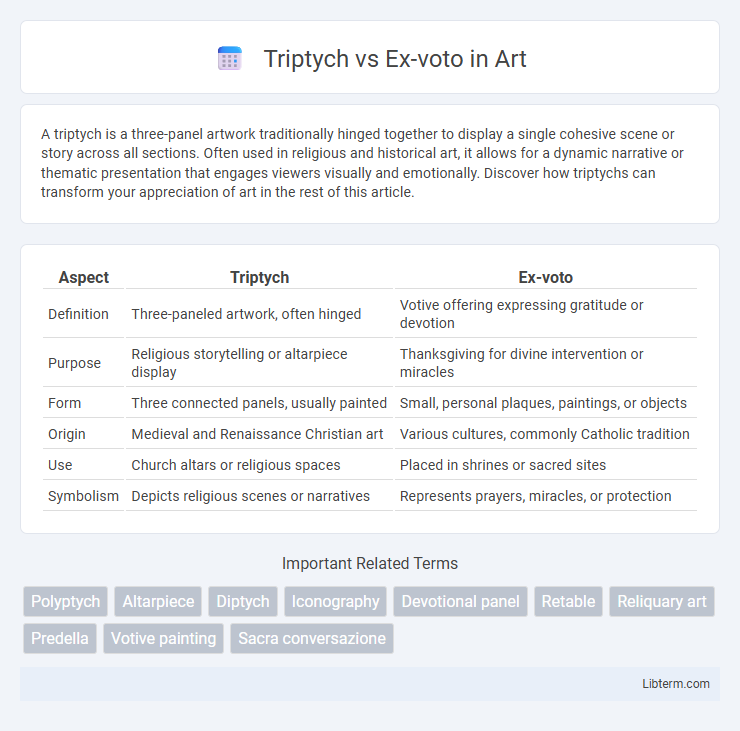A triptych is a three-panel artwork traditionally hinged together to display a single cohesive scene or story across all sections. Often used in religious and historical art, it allows for a dynamic narrative or thematic presentation that engages viewers visually and emotionally. Discover how triptychs can transform your appreciation of art in the rest of this article.
Table of Comparison
| Aspect | Triptych | Ex-voto |
|---|---|---|
| Definition | Three-paneled artwork, often hinged | Votive offering expressing gratitude or devotion |
| Purpose | Religious storytelling or altarpiece display | Thanksgiving for divine intervention or miracles |
| Form | Three connected panels, usually painted | Small, personal plaques, paintings, or objects |
| Origin | Medieval and Renaissance Christian art | Various cultures, commonly Catholic tradition |
| Use | Church altars or religious spaces | Placed in shrines or sacred sites |
| Symbolism | Depicts religious scenes or narratives | Represents prayers, miracles, or protection |
Introduction to Triptychs and Ex-votos
Triptychs are three-paneled artworks typically used in religious contexts to narrate a story or depict a central theme with flanking supportive scenes, often hinged for folding. Ex-votos are devotional objects offered in fulfillment of a vow or in gratitude, frequently portraying miraculous events or prayers for healing. Both serve spiritual purposes but differ in format and cultural function, with triptychs emphasizing artistic storytelling and ex-votos focusing on personal devotion and testimony.
Historical Origins of Triptychs
Triptychs originated in early Christian art during the late Roman Empire, serving as portable altarpieces for worship and instruction. These three-paneled artworks allowed for a central religious image flanked by complementary scenes, enhancing narrative depth and devotional focus. In contrast, Ex-votos primarily functioned as votive offerings expressing gratitude or requests for divine intervention, often less structured in form and rooted in folk traditions rather than formal liturgical settings.
Historical Development of Ex-votos
Ex-votos originated in ancient religious practices as devotional offerings expressing gratitude or seeking divine intervention, evolving from simple objects to intricate artworks over centuries. Historically, ex-votos have been integral to many cultures, particularly in Catholic traditions, where they often appear as paintings, plaques, or sculptures representing miracles or answered prayers. Unlike triptychs, which are primarily altarpieces divided into three panels for narrative and devotional purposes, ex-votos primarily serve as personal tokens of faith or commemoration without a standardized artistic format.
Artistic Structure: Triptych Design
A triptych consists of three connected panels, typically hinged together, allowing for a central larger panel flanked by two smaller wings that can close over it, creating a dynamic visual narrative. This structure enables artists to depict a cohesive story or thematic progression across the panels, often enhancing religious or mythological scenes with a clear focal point in the central panel. In contrast, an ex-voto is usually a single panel or object offered as a votive gift and lacks the multi-panel, hinged design characteristic of the triptych.
Symbolism and Purpose of Ex-votos
Ex-votos serve as tangible expressions of gratitude or devotion, often symbolizing personal miracles or answered prayers within religious contexts. Unlike triptychs, which are primarily artistic altarpieces depicting biblical scenes for contemplation, ex-votos function as votive offerings representing individual stories of faith and divine intervention. Their symbolism centers on personal connection, healing, and spiritual testimony rather than formal narrative or theological themes found in triptychs.
Religious and Cultural Significance
Triptychs, composed of three hinged panels, serve as devotional altarpieces in Christian art, symbolizing the Holy Trinity and facilitating narrative storytelling in religious ceremonies. Ex-votos are offerings made in gratitude for divine intervention, often inscribed with prayers or depictions of miracles, reflecting deep personal and communal faith within cultural contexts. Both artifacts embody profound religious significance, with triptychs emphasizing doctrinal teaching and worship, while ex-votos highlight individual piety and the cultural practice of vow fulfillment.
Key Differences Between Triptychs and Ex-votos
Triptychs are three-paneled artworks often used as altarpieces in Christian art, featuring central religious scenes flanked by related narratives or saints. Ex-votos are devotional objects or paintings created as offerings of gratitude or petitions for divine intervention, usually smaller and personalized with specific prayers or images of healings. The key difference lies in triptychs serving liturgical and narrative functions, while ex-votos primarily act as personal expressions of faith and thankfulness.
Famous Examples in Art History
Triptychs and ex-votos serve distinct purposes in art history, with famous triptychs like Hieronymus Bosch's "The Garden of Earthly Delights" illustrating complex religious narratives across three panels. Ex-votos, such as the Mexican votive paintings found at the Museo Frida Kahlo, typically represent personal acts of gratitude or devotion, often depicting miraculous interventions. These works underscore differing artistic intentions: triptychs emphasize liturgical storytelling, while ex-votos highlight individual expressions of faith and thanks.
Contemporary Uses and Interpretation
Triptychs in contemporary art often serve as multifaceted narratives or conceptual frameworks that explore complex themes through three interconnected panels, allowing artists to juxtapose diverse ideas or temporal moments. Ex-votos in modern contexts transcend their traditional devotional purpose, functioning as personal testimonies or social commentaries that highlight individual or collective experiences of trauma, gratitude, or survival. Both forms have evolved beyond their historical religious functions, becoming vehicles for artists to engage audiences in dialogues about memory, identity, and cultural heritage.
Conclusion: Choosing Between Triptych and Ex-voto
Choosing between a triptych and an ex-voto depends on the intended purpose and cultural context; triptychs are typically multi-paneled artworks used for religious storytelling or altarpiece decoration, while ex-votos are offerings expressing gratitude or devotion, often in the form of plaques or small paintings. Triptychs emphasize narrative and visual complexity, enhancing liturgical spaces, whereas ex-votos convey personal or communal acts of faith and thankfulness. Selecting one over the other hinges on whether the goal is to create a structured religious iconography or to commemorate a specific miracle or divine intervention.
Triptych Infographic

 libterm.com
libterm.com